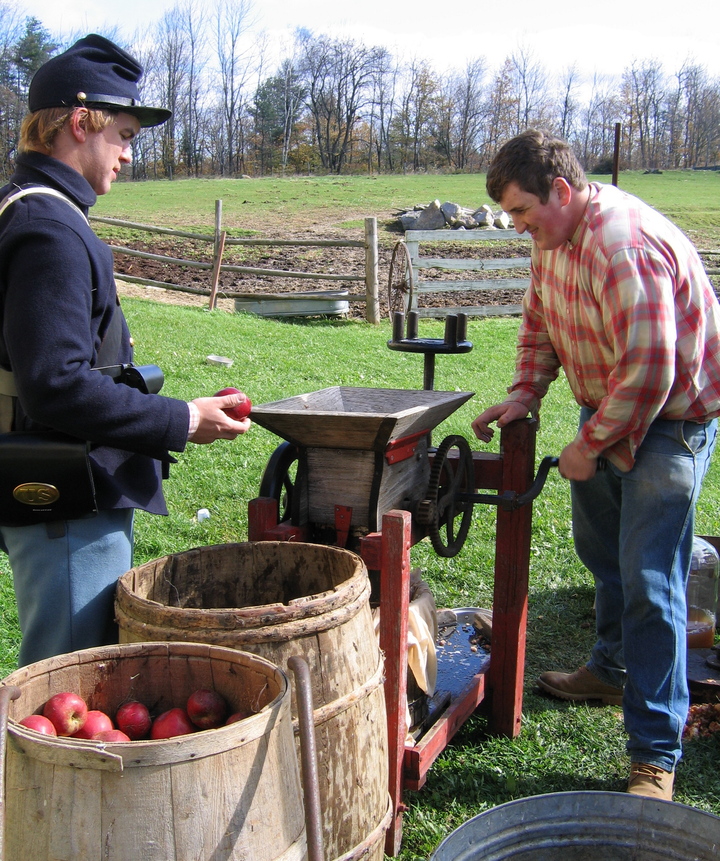A festival Saturday at the nonprofit center will support the fundraising drive to rebuild a barn that was lost to fire.
It’s been more than five years since a fire leveled a historic barn at the Washburn-Norlands Living History Center in Livermore, but a recent $5,000 matching grant pledge has museum officials hopeful that a new structure will rise next spring.
Once the hub of activity for the living history presentations offered at the center, the barn caught fire on the night of April 28, 2008.
The blaze, started by a heating lamp warming a sow and her newborn piglets, gutted the building, killing several farm animals and nearly reaching the centerpiece of the complex, the 1867 Washburn Mansion (built after destructive fires in 1847 and 1867).
Quick-thinking firefighters used an excavator to raze a farmer’s cottage that tied the barn to the mansion to keep the fire from spreading to the Italianate-style home that contains most of the antique furnishings on the property.
Norlands Director Sheri Leahan said the cottage was rebuilt in 2011 through an earlier phase of fundraising efforts. Now staffers are engaged in what they hope will be the final campaign to complete the rebuilding, estimated to cost $250,000.
The center is appealing to the community to help raise funds for the new barn. The deadline is Oct. 31 for donors to take advantage of the $5,000 matching donation pledged by Otis Federal Credit Union of Jay.
This weekend, the public is invited to come to the complex to see what all the fuss is about.
Norlands will host a fall festival from 10 a.m. to 4 p.m. Saturday, offering crafts, wagon rides, nature walks, tours, Caroline’s Closet dress up, a penmanship contest in the one-room schoolhouse, cooking and apple activities, square dancing, period games and a book signing by author Donna Seim.
Kettle corn will be sold and a silent auction held to benefit the barn-raising fund.
“The barn that burned in 2008 was actually the second barn on this site,” said Leahan. “That barn, built in the early 1900s, looked more like dairy barns common to that period. Our new barn will return to the original 1867 design that was originally here.”
The foundation of the new barn, which is 40 feet by 85 feet, follows a similar footprint to the destroyed one, but has a concrete-reinforced basement that provides temporary housing for cattle and storage needs.
“The hope is to have funds in hand to raise a post-and-beam frame, enclose it in with sheathing and add a roof next spring,” said Leahan. “Depending on how much money we raise, we will add clapboard siding, cupolas and complete the interior, building stalls for the animals and making sure things are up to safety codes – everything needed to make this a complete, working barn.”
The living history center, now a nonprofit that exists to interpret life in the 1870s, is the ancestral home of the Israel Washburn family that settled here in 1809.
The Washburns’ 10 children were raised here in a simple farmhouse and many of the children went on to have successful careers in politics and business. Israel Washburn Jr. became governor of Maine during the Civil War period and three other brothers served as members of Congress.
The children later built the mansion to honor their hard-working parents.
“The Washburns were raised in a humble setting during hard times but they went off and did incredible things,” said Leahan. “The center celebrates the times and legacy of the Washburns as well as the lives of their neighbors and traditional rural Maine farm life.”
The center offers several living history immersion programs each year, giving participants (from children to adults) the opportunity to take on the roles of people who once lived in the area and learn farm and housekeeping practices of the 19th century.
A replica 1853 one-room schoolhouse offers period lessons with a school marm and students using quill pens to write.
Other historic structures on the property include an 1828 meetinghouse, (formerly a Universality Unitarian Church) and an 1883 library.
Since the barn burned down, programs have been held in the farmers cottage, an old tool shed and outdoors, weather permitting.
Leahan said that until the new barn is built, “(visitors) are not getting the full Norlands experience and authenticity of working in an actual barn setting. But we are really excited to get that back. It’s part of the magic of Norlands. What we have here is unique and rare.”
Deborah Sayer can be contacted at 791-6308 or at:
Send questions/comments to the editors.



Success. Please wait for the page to reload. If the page does not reload within 5 seconds, please refresh the page.
Enter your email and password to access comments.
Hi, to comment on stories you must . This profile is in addition to your subscription and website login.
Already have a commenting profile? .
Invalid username/password.
Please check your email to confirm and complete your registration.
Only subscribers are eligible to post comments. Please subscribe or login first for digital access. Here’s why.
Use the form below to reset your password. When you've submitted your account email, we will send an email with a reset code.